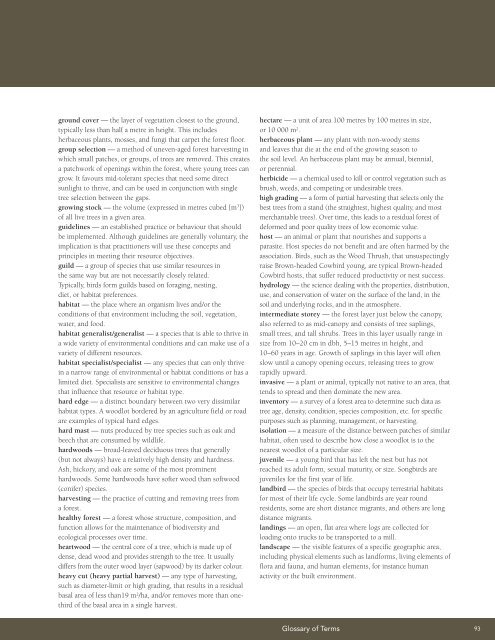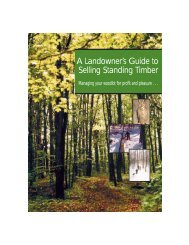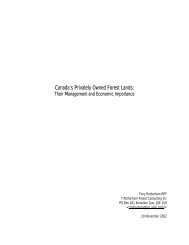A land manager's guide to conserving habitat for forest birds in ...
A land manager's guide to conserving habitat for forest birds in ...
A land manager's guide to conserving habitat for forest birds in ...
You also want an ePaper? Increase the reach of your titles
YUMPU automatically turns print PDFs into web optimized ePapers that Google loves.
ground cover — the layer of vegetation closest <strong>to</strong> the ground,<br />
typically less than half a metre <strong>in</strong> height. This <strong>in</strong>cludes<br />
herbaceous plants, mosses, and fungi that carpet the <strong>for</strong>est floor.<br />
group selection — a method of uneven-aged <strong>for</strong>est harvest<strong>in</strong>g <strong>in</strong><br />
which small patches, or groups, of trees are removed. This creates<br />
a patchwork of open<strong>in</strong>gs with<strong>in</strong> the <strong>for</strong>est, where young trees can<br />
grow. It favours mid-<strong>to</strong>lerant species that need some direct<br />
sunlight <strong>to</strong> thrive, and can be used <strong>in</strong> conjunction with s<strong>in</strong>gle<br />
tree selection between the gaps.<br />
grow<strong>in</strong>g s<strong>to</strong>ck — the volume (expressed <strong>in</strong> metres cubed [m 3 ])<br />
of all live trees <strong>in</strong> a given area.<br />
<strong>guide</strong>l<strong>in</strong>es — an established practice or behaviour that should<br />
be implemented. Although <strong>guide</strong>l<strong>in</strong>es are generally voluntary, the<br />
implication is that practitioners will use these concepts and<br />
pr<strong>in</strong>ciples <strong>in</strong> meet<strong>in</strong>g their resource objectives.<br />
guild — a group of species that use similar resources <strong>in</strong><br />
the same way but are not necessarily closely related.<br />
Typically, <strong>birds</strong> <strong>for</strong>m guilds based on <strong>for</strong>ag<strong>in</strong>g, nest<strong>in</strong>g,<br />
diet, or <strong>habitat</strong> preferences.<br />
<strong>habitat</strong> — the place where an organism lives and/or the<br />
conditions of that environment <strong>in</strong>clud<strong>in</strong>g the soil, vegetation,<br />
water, and food.<br />
<strong>habitat</strong> generalist/generalist — a species that is able <strong>to</strong> thrive <strong>in</strong><br />
a wide variety of environmental conditions and can make use of a<br />
variety of different resources.<br />
<strong>habitat</strong> specialist/specialist — any species that can only thrive<br />
<strong>in</strong> a narrow range of environmental or <strong>habitat</strong> conditions or has a<br />
limited diet. Specialists are sensitive <strong>to</strong> environmental changes<br />
that <strong>in</strong>fluence that resource or <strong>habitat</strong> type.<br />
hard edge — a dist<strong>in</strong>ct boundary between two very dissimilar<br />
<strong>habitat</strong> types. A woodlot bordered by an agriculture field or road<br />
are examples of typical hard edges.<br />
hard mast — nuts produced by tree species such as oak and<br />
beech that are consumed by wildlife.<br />
hardwoods — broad-leaved deciduous trees that generally<br />
(but not always) have a relatively high density and hardness.<br />
Ash, hickory, and oak are some of the most prom<strong>in</strong>ent<br />
hardwoods. Some hardwoods have softer wood than softwood<br />
(conifer) species.<br />
harvest<strong>in</strong>g — the practice of cutt<strong>in</strong>g and remov<strong>in</strong>g trees from<br />
a <strong>for</strong>est.<br />
healthy <strong>for</strong>est — a <strong>for</strong>est whose structure, composition, and<br />
function allows <strong>for</strong> the ma<strong>in</strong>tenance of biodiversity and<br />
ecological processes over time.<br />
heartwood — the central core of a tree, which is made up of<br />
dense, dead wood and provides strength <strong>to</strong> the tree. It usually<br />
differs from the outer wood layer (sapwood) by its darker colour.<br />
heavy cut (heavy partial harvest) — any type of harvest<strong>in</strong>g,<br />
such as diameter-limit or high grad<strong>in</strong>g, that results <strong>in</strong> a residual<br />
basal area of less than19 m 2 /ha, and/or removes more than onethird<br />
of the basal area <strong>in</strong> a s<strong>in</strong>gle harvest.<br />
hectare — a unit of area 100 metres by 100 metres <strong>in</strong> size,<br />
or 10 000 m 2 .<br />
herbaceous plant — any plant with non-woody stems<br />
and leaves that die at the end of the grow<strong>in</strong>g season <strong>to</strong><br />
the soil level. An herbaceous plant may be annual, biennial,<br />
or perennial.<br />
herbicide — a chemical used <strong>to</strong> kill or control vegetation such as<br />
brush, weeds, and compet<strong>in</strong>g or undesirable trees.<br />
high grad<strong>in</strong>g — a <strong>for</strong>m of partial harvest<strong>in</strong>g that selects only the<br />
best trees from a stand (the straightest, highest quality, and most<br />
merchantable trees). Over time, this leads <strong>to</strong> a residual <strong>for</strong>est of<br />
de<strong>for</strong>med and poor quality trees of low economic value.<br />
host — an animal or plant that nourishes and supports a<br />
parasite. Host species do not benefit and are often harmed by the<br />
association. Birds, such as the Wood Thrush, that unsuspect<strong>in</strong>gly<br />
raise Brown-headed Cowbird young, are typical Brown-headed<br />
Cowbird hosts, that suffer reduced productivity or nest success.<br />
hydrology — the science deal<strong>in</strong>g with the properties, distribution,<br />
use, and conservation of water on the surface of the <strong>land</strong>, <strong>in</strong> the<br />
soil and underly<strong>in</strong>g rocks, and <strong>in</strong> the atmosphere.<br />
<strong>in</strong>termediate s<strong>to</strong>rey — the <strong>for</strong>est layer just below the canopy,<br />
also referred <strong>to</strong> as mid-canopy and consists of tree sapl<strong>in</strong>gs,<br />
small trees, and tall shrubs. Trees <strong>in</strong> this layer usually range <strong>in</strong><br />
size from 10–20 cm <strong>in</strong> dbh, 5–15 metres <strong>in</strong> height, and<br />
10–60 years <strong>in</strong> age. Growth of sapl<strong>in</strong>gs <strong>in</strong> this layer will often<br />
slow until a canopy open<strong>in</strong>g occurs, releas<strong>in</strong>g trees <strong>to</strong> grow<br />
rapidly upward.<br />
<strong>in</strong>vasive — a plant or animal, typically not native <strong>to</strong> an area, that<br />
tends <strong>to</strong> spread and then dom<strong>in</strong>ate the new area.<br />
<strong>in</strong>ven<strong>to</strong>ry — a survey of a <strong>for</strong>est area <strong>to</strong> determ<strong>in</strong>e such data as<br />
tree age, density, condition, species composition, etc. <strong>for</strong> specific<br />
purposes such as plann<strong>in</strong>g, management, or harvest<strong>in</strong>g.<br />
isolation — a measure of the distance between patches of similar<br />
<strong>habitat</strong>, often used <strong>to</strong> describe how close a woodlot is <strong>to</strong> the<br />
nearest woodlot of a particular size.<br />
juvenile — a young bird that has left the nest but has not<br />
reached its adult <strong>for</strong>m, sexual maturity, or size. Song<strong>birds</strong> are<br />
juveniles <strong>for</strong> the first year of life.<br />
<strong>land</strong>bird — the species of <strong>birds</strong> that occupy terrestrial <strong>habitat</strong>s<br />
<strong>for</strong> most of their life cycle. Some <strong>land</strong><strong>birds</strong> are year round<br />
residents, some are short distance migrants, and others are long<br />
distance migrants.<br />
<strong>land</strong><strong>in</strong>gs — an open, flat area where logs are collected <strong>for</strong><br />
load<strong>in</strong>g on<strong>to</strong> trucks <strong>to</strong> be transported <strong>to</strong> a mill.<br />
<strong>land</strong>scape — the visible features of a specific geographic area,<br />
<strong>in</strong>clud<strong>in</strong>g physical elements such as <strong>land</strong><strong>for</strong>ms, liv<strong>in</strong>g elements of<br />
flora and fauna, and human elements, <strong>for</strong> <strong>in</strong>stance human<br />
activity or the built environment.<br />
Glossary of Terms 93

















